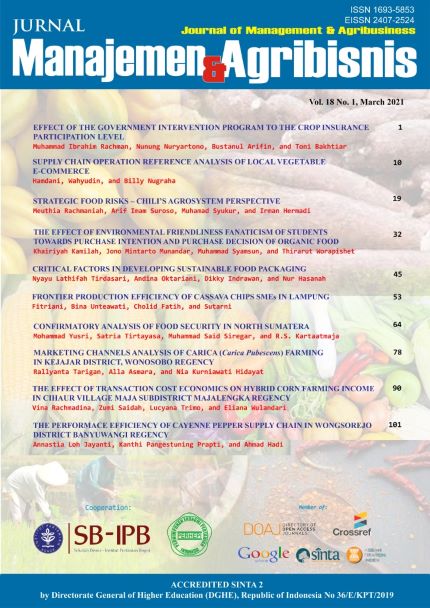MARKETING CHANNELS ANALYSIS OF CARICA (Carica Pubescens) FARMING IN KEJAJAR DISTRICT, WONOSOBO REGENCY
Abstract
The main problem of Carica farming in Kejajar District was the differences in farmers' prices in the collection and processing Carica fruit industry. The product marketed by the farmers was fresh Carica fruit and information about the minimum selling price caused them to be unable to determine the right institution. These problems affected Carica's marketing channel, leading to market inefficiencies. This study's place was selected purposively in Kejajar District, Wonosobo Regency, with the consideration that Kejajar Subdistrict is a Carica center with a production of 4,589 tons (68%) of the total Carica production in Wonosobo Regency. The research was conducted from October - November 2020. The Structure Conduct Performance (SCP) method was used to analyze the marketing channels. The results of the marketing channel analysis show that the market structure formed at the farm level was in the form of a purely competitive market, and at the trader level, the market structure was formed by oligopoly. There were six Carica-marketing channels with cash payment systems, and the merchant determined the purchase price. The highest farmer’s share and profit to cost ratio was channel I (farmer → processing industry) and VI (farmer → village collector → processing industry). The marketing efficiency analysis results show that the marketing of Carica was inefficient because the farmer's share at four marketing channels received by farmers was still less than 40%.
Keywords: Carica (Carica pubescens), farming, marketing channels, marketing efficiency, SCP
Authors
Authors who publish with this journal agree to the following terms:
- Authors retain copyright and grant the journal right of first publication with the work simultaneously licensed under a Creative Commons Attribution License that allows others to share the work with an acknowledgement of the work's authorship and initial publication in this journal.
- Authors are able to enter into separate, additional contractual arrangements for the non-exclusive distribution of the journal's published version of the work (e.g., post it to an institutional repository or publish it in a book), with an acknowledgement of its initial publication in this journal.
- Authors are permitted and encouraged to post their work online (e.g., in institutional repositories or on their website) prior to and during the submission process, as it can lead to productive exchanges, as well as earlier and greater citation of published work (See The Effect of Open Access).

